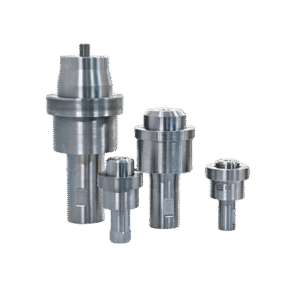High-Performance Ultrasonic Booster for Amplitude Control
Our ultrasonic boosters (amplitude transformers) convert and amplify mechanical vibrations from 15kHz to 40kHz systems, ensuring optimal energy transfer in plastic welding, metal bonding, and textile sealing applications.

Parameter table
| Frequency Range | 15kHz, 20kHz, 28kHz, 30kHz, 35kHz, 40kHz |
|---|---|
| Amplification Ratio | 1:1.2 to 1:3.5 |
| Materials | Ti-6Al-4V, 4140 Steel, Aluminum 7075 |
| Surface Finish | Ra ≤ 0.8μm (mirror optional) |
Customer FAQs
Why does my ultrasonic booster overheat?
Your ultrasonic booster likely overheats due to: frequency mismatch (using the wrong kHz rating), excessive amplitude (beyond its designed ratio), or poor cooling (lack of airflow/water cooling). Other causes include loose mounting (vibration friction), material cracks (fatigue from prolonged use), or contaminated surfaces (dirt/oil disrupting energy transfer).
What is an ultrasonic booster and how does it work?
An ultrasonic booster is a metal component that amplifies or reduces vibration amplitude between the transducer and welding horn. It works by altering the cross-sectional area ratio (e.g., 1:2 ratio doubles the amplitude) at the same frequency (15-40kHz).
How to calculate booster amplification ratio?
Ratio = Output Amplitude ÷ Input Amplitude. Example: 30μm input → 90μm output = 1:3 ratio
How to test if an ultrasonic booster is damaged?
Perform:
✅ Visual inspection (cracks/discoloration)
✅ Frequency scan (deviation > ±0.5kHz = faulty)
✅ Amplitude measurement (uneven output = internal fatigue)
Can I use one booster for different ultrasonic welding applications?
Not recommended. Each booster is tuned for specific:
🔧 Amplitude ratio
🔧 Frequency (15/20/30/40kHz)
🔧 Material (titanium for high power, steel for durability)
What’s the difference between a booster and a horn?
Booster: Modifies amplitude (mounted between transducer & horn)
Horn (Sonotrode): Directly contacts workpiece for welding
